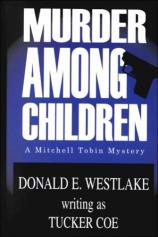Murder Among Children
Review
Murder Among Children
There are some authors who simply burst with stories to tell. Some exceed the capacity, at least in theory, of what the publishing market will bear. Accordingly, they turn to a pseudonym under which to publish some of their work. Stephen King and Dean Koontz spring most immediately to mind as examples; another, however, is Donald Westlake. Westlake's best-known alter ego is Richard Stark, a vehicle he still utilizes for his brilliant, under appreciated Parker novels. What perhaps isn't as widely known is that Westlake also published a series of novels in the 1960s under the name Tucker Coe. These novels concerned Mitchell Tobin, a disgraced cop who wants to isolate himself from the world yet keeps finding himself by haphazard circumstance being reluctantly drawn back into the life. Five Star is in the process of bringing the Mitchell Tobin books back into print. May a thousand blessings rest upon it for this good work. The Tobin books, taken together, constitute an almost hidden history of modern crime fiction.
MURDER AMONG CHILDREN, the second of the Tobin books, opens with Tobin living in isolation and personal disgrace following his embarrassing discharge from the police force. The circumstances of Tobin's termination are revealed in the narration and are best described there. Tobin is visited by Robin Kennely, a cousin whom he has never met. Robin is associated with a Greenwich Village coffee house that is apparently being shaken down by a police detective and she asks Tobin to visit the coffeehouse and talk with the officer to see exactly what he wants. When Tobin reluctantly does so, at the gentle but persistent urging of his wife, he stumbles upon a double murder, which apparently has been committed by Robin. She not only has motive and opportunity, in a deft variation of the classic "locked room" mystery, it appears that she is the only one who could possibly have committed the murder. Tobin, to make matters worse, appears to be a witness against her.
Although Tobin wishes to have no further involvement in the matter, he nonetheless finds himself pulled into it degree by degree, consciously resisting but unconsciously drawn to it. The reader, meanwhile, is given a sociological and geographical triptych of New York City in the late 1960s, while being taken step by step through a mystery in its most classical sense. Interestingly enough, MURDER AMONG CHILDREN does not end with explosions, car chases, or cliffhangings. The bombshell lies in the quiet revelation of what occurred.
Westlake, in his new forward to MURDER AMONG CHILDREN, discusses how Tobin came to be and why there are only five Tobin novels. His account stands as a revealing portrait of the creative process as well as a quiet testimony to artistic and professional integrity and honesty. MURDER AMONG CHILDREN, with the other forthcoming Tobin books, constitutes a snapshot of the early development of one of the under acknowledged masters of American literature. Anyone with even a remote interest in the mystery genre should make room for this volume and its forthcoming siblings on their bookshelf.
Reviewed by Joe Hartlaub on November 1, 2000










